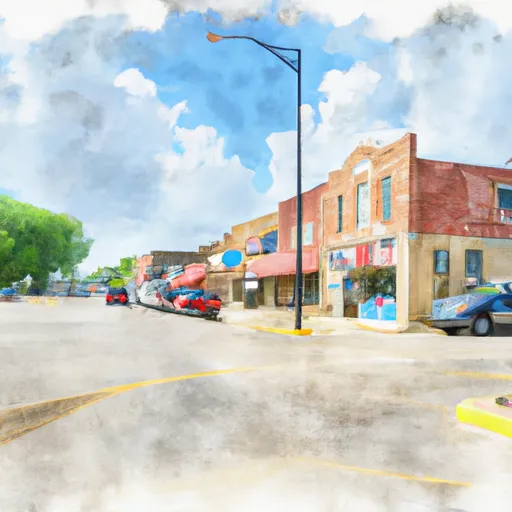-
 Snoflo Premium
Snoflo Premium
Get unlimited access to all our content
With no Ad interruptions! - Start Your Free Trial Login with existing account
Blue-Mound
Eden Index
Climate
9.7
•
Recreation
•
Community
•
Safeguard
3.9/10

Blue Mound, Kansas is a small, rural community located in Linn County. The climate is characterized by hot summers and cold winters, with precipitation fairly evenly distributed throughout the year. The primary hydrology constituent in the area is the Marais des Cygnes River, which runs through the town and provides opportunities for fishing and boating. Outdoor recreation opportunities in the area include the Marais des Cygnes Wildlife Area, which offers hunting, fishing, and wildlife viewing opportunities, as well as hiking and camping. The nearby Sugar Valley Lakes provide additional opportunities for boating, fishing, and swimming. Overall, Blue Mound offers a quiet, rural escape with plenty of opportunities to enjoy the outdoors.
What is the Eden Index?
The Snoflo Eden Index serves as a comprehensive rating system for regions, evaluating their desirability through a holistic assessment of climate health, outdoor recreation opportunities, and natural disaster risk, acknowledging the profound impact of these factors on livability and well-being.
Climate Health Indicator (CHI): 9.7
Blue-Mound receives approximately
1067mm of rain per year,
with humidity levels near 79%
and air temperatures averaging around
13°C.
Blue-Mound has a plant hardyness factor of
6, meaning
plants and agriculture in this region thrive during a short period during spring and early summer. Most
plants will die off during the colder winter months.
By considering the ideal temperature range, reliable water supplies, clean air, and stable seasonal rain or snowpacks, the Climate Health Indicator (CHI) underscores the significance of a healthy climate as the foundation for quality living.
A healthy climate is paramount for ensuring a high quality of life and livability in a region, fostering both physical well-being and environmental harmony. This can be characterized by ideal temperatures, reliable access to water supplies, clean air, and consistent seasonal rain or snowpacks.
Weather Forecast
Streamflow Conditions
Osage
Area Rivers
Osage
Snowpack Depths
Osage
Reservoir Storage Capacity
Osage
Groundwater Levels
Recreational Opportunity Index (ROI):
The Recreational Opportunity Index (ROI) recognizes the value of outdoor recreational options, such as parks, hiking trails, camping sites, and fishing spots, while acknowledging that climate plays a pivotal role in ensuring the comfort and consistency of these experiences.
Access to outdoor recreational opportunities, encompassing activities such as parks, hiking, camping, and fishing, is crucial for overall well-being, and the climate plays a pivotal role in enabling and enhancing these experiences, ensuring that individuals can engage in nature-based activities comfortably and consistently.
Camping Areas
| Campground | Campsites | Reservations | Toilets | Showers | Elevation |
|---|---|---|---|---|---|
| Chicken Creek - Tenkiller Ferry Lake | None | 710 ft | |||
| Petit Bay - Tenkiller Ferry Lake | None | 793 ft | |||
| Cookson Bend - Tenkiller Ferry Lake | None | 646 ft | |||
| Greenleaf State Park | None | 699 ft | |||
| Blackhawk RV Military - Camp Gruber | None | 590 ft | |||
| Snake Creek Cove - Tenkiller Ferry Lake | None | 638 ft | |||
| Elk Creek Landing - Tenkiller Ferry Lake | None | 687 ft | |||
| Sizemore Landing - Tenkiller Ferry Lake | None | 633 ft | |||
| Cato Creek Landing - Tenkiller Ferry Lake | None | 668 ft | |||
| Standing Rock - Tenkiller Ferry Lake | None | 700 ft |
Nearby Fishing
Catastrophe Safeguard Index (CSI):
The Catastrophe Safeguard Index (CSI) recognizes that natural disaster risk, encompassing floods, fires, hurricanes, and tornadoes, can drastically affect safety and the overall appeal of an area.
The level of natural disaster risk in a region significantly affects safety and the overall livability, with climate change amplifying these risks by potentially increasing the frequency and intensity of events like floods, fires, hurricanes, and tornadoes, thereby posing substantial challenges to community resilience and well-being.
Community Resilience Indicator (CRI):
The Community Resilience Indicator (CRI) recognizes that education, healthcare, and socioeconomics are crucial to the well-being of a region. The CRI acknowledges the profound impact of these elements on residents' overall quality of life. By evaluating educational resources, healthcare accessibility, and economic inclusivity, the index captures the essential aspects that contribute to a thriving community, fostering resident satisfaction, equity, and social cohesion.

